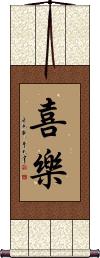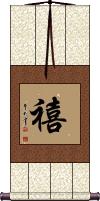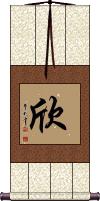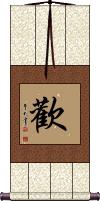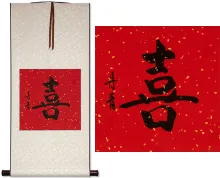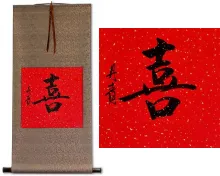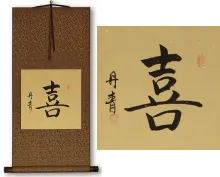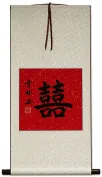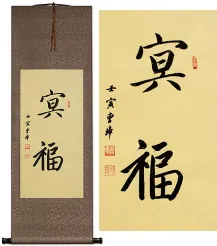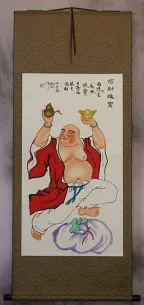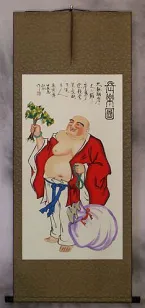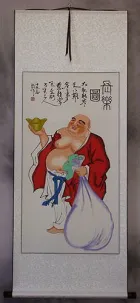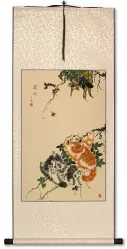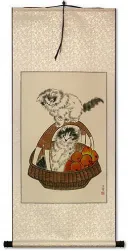Many custom options...
And formats...

Joy in Chinese / Japanese...
Buy a Joy calligraphy wall scroll here!
Personalize your custom “Joy” project by clicking the button next to your favorite “Joy” title below...
Happiness / Joyful / Joy
喜 is the Chinese, Japanese Kanji, and Korean Hanja for the kind of happiness known in the west as “joy.”
喜 can also be translated as rejoice, enjoyment, delighted, pleased, or “take pleasure in.” Sometimes it can mean “to be fond of” (in a certain context).
If you write two of these happiness/joy characters side by side, you create another character known in English as “double happiness,” which is a symbol associated with weddings and happy marriages.
There is another version of this character that you will find on our website with an additional radical on the left side (exactly same meaning, just an alternate form). The version of happiness shown here is the commonly written form in China, Japan and South Korea (banned in North Korea).
See Also: Contentment | Happiness | Joy
Happiness / Joy
禧 is the type of happiness known in the west as “joy.”
The radical on the right side of this character is often seen alone (with the same meaning - and we do recommend that version because it's more universal).
Happy
欣 is the type of happiness that you feel on the inside. It is the feeling of being released and delighted as well as being in a state of contentment. 欣 is more the internal happiness that perhaps only shows by the smile on your face. It can also be translated as “to take pleasure in” or “to rejoice.”
Note: 欣 is often used in compound words - especially in Korean Hanja.
As Japanese Kanji, this is so rare, that most Japanese people are not aware of its existence.
See Also: Happiness
Joyful
歡 means joyous, happy, delightful, and pleased.
歡 represents external happiness that may have you clapping and cheering.
Please note: The other happiness/joyful which looks like "喜" is more popular.
歡 is the ancient/old version in China and Japan. After WWII in Japan, they started using 歓. Just let us know if you want this modern version instead of the ancient one.
See Also: Happiness
This in-stock artwork might be what you are looking for, and ships right away...
Gallery Price: $65.00
Your Price: $39.88
Gallery Price: $65.00
Your Price: $39.88
Gallery Price: $65.00
Your Price: $39.88
Gallery Price: $72.00
Your Price: $39.88
Gallery Price: $63.00
Your Price: $35.00
Gallery Price: $200.00
Your Price: $69.88
Gallery Price: $61.00
Your Price: $33.88
These search terms might be related to Joy:
A Life of Happiness and Prosperity
Charisma / Charm
Charm / Grace
Dharma Gate of Bliss
Doing Good is the Greatest Source of Happiness
Double Happiness
Double Happiness Guest Book
Eternal Happiness
Eternal Peace and Happiness
Family Love / Domestic Bliss
Feeling of Bliss
Happiness
Happiness / Contentment
Happiness / Fortune / Lucky
Happiness / Joy
Happiness / Joyful / Joy
Happiness in the Afterlife
Happy / Laughter / Cheerful Bliss
Inner Bliss and Peace From Meditation
Joyfulness / Happiness
Love and Happiness
Peace, Love, Happiness
Pleasure
Prosperity and Happiness
Pursuit of Happiness
School of Happiness
Seven Rules of Happiness
Sweet / Sweetness / Charm
There is No Pleasure Without Pain
Not the results for Joy that you were looking for?
Below are some entries from our dictionary that may match your Joy search...
| Characters If shown, 2nd row is Simp. Chinese |
Pronunciation Romanization |
Simple Dictionary Definition |
喜 see styles |
xǐ xi3 hsi yoshimi よしみ |
More info & calligraphy: Happiness / Joyful / Joy(female given name) Yoshimi prīti; ānanda. Joy; glad; delighted, rejoice; to like. |
欣 see styles |
xīn xin1 hsin yoshi よし |
More info & calligraphy: Happy(personal name) Yoshi Joyful, elated, elevated. |
禧 see styles |
xǐ xi3 hsi ki き |
More info & calligraphy: Happiness / Joy(male given name) Ki |
賓 宾 see styles |
bīn bin1 pin bin びん |
More info & calligraphy: Bean(out-dated or obsolete kana usage) visitor from afar; guest; (1) visitor from afar; (2) joy-bringing spirit from the divine realms; (surname) Bin A guest; to entertain; to submit. |
十法 see styles |
shí fǎ shi2 fa3 shih fa jippō |
More info & calligraphy: Ten perfect Mahayana rules |
喜樂 喜乐 see styles |
xǐ lè xi3 le4 hsi le kiraku |
More info & calligraphy: Joydelight |
幸福 see styles |
xìng fú xing4 fu2 hsing fu shiawase しあわせ |
More info & calligraphy: Happiness(noun or adjectival noun) happiness; well-being; joy; welfare; blessedness; (surname, female given name) Shiawase |
快感 see styles |
kuài gǎn kuai4 gan3 k`uai kan kuai kan kaikan かいかん |
More info & calligraphy: Pleasant Feelingpleasant feeling; pleasant sensation; pleasure |
快樂 快乐 see styles |
kuài lè kuai4 le4 k`uai le kuai le keraku |
More info & calligraphy: Joyfulness / HappinessJoyful. |
愛樂 爱乐 see styles |
ài yuè ai4 yue4 ai yüeh aira あいら |
More info & calligraphy: Aile(female given name) Aira The joy of right love, i.e. the love of the good. |
無量 无量 see styles |
wú liàng wu2 liang4 wu liang muryou / muryo むりょう |
More info & calligraphy: Immeasurable / Unlimited(adj-no,n) immeasurable; infinite; inestimable; (given name) Muryō apramāṇa; amita; ananta; immeasurable, unlimited, e.g. the 'four infinite' characteristics of a bodhisattva are 慈悲喜捨 kindness, pity, joy, and self-sacrifice. |
禪悅 禅悦 see styles |
chán yuè chan2 yue4 ch`an yüeh chan yüeh zenetsu |
More info & calligraphy: Inner Bliss and Peace from Meditation |
開花 开花 see styles |
kāi huā kai1 hua1 k`ai hua kai hua haruka はるか |
More info & calligraphy: Opening / Blooming Flowers(n,vs,vi) (1) flowering; blooming; blossoming; coming into bloom; (n,vs,vi) (2) flowering (of a civilization, talent, etc.); blossoming; blooming; bearing fruit (of efforts); (female given name) Haruka |
ジョイ see styles |
joi ジョイ |
More info & calligraphy: Joye |
四無量心 四无量心 see styles |
sì wú liàng xīn si4 wu2 liang4 xin1 ssu wu liang hsin shi muryōshin |
More info & calligraphy: Brahmavihara - The Four Immeasurables |
天倫之樂 天伦之乐 see styles |
tiān lún zhī lè tian1 lun2 zhi1 le4 t`ien lun chih le tien lun chih le |
More info & calligraphy: Family Love / Domestic Bliss |
為善最樂 为善最乐 see styles |
wéi shàn zuì lè wei2 shan4 zui4 le4 wei shan tsui le |
More info & calligraphy: Doing good is the greatest source of happiness |
忻 see styles |
xīn xin1 hsin kon |
happy Delight, joy. |
悰 see styles |
cóng cong2 ts`ung tsung |
joy |
樂 乐 see styles |
yuè yue4 yüeh ran らん |
music (surname) Ran Music, that which causes joy, hence joy, joyful, glad, rejoice; also to find joy in, enjoy. |
歓 see styles |
huān huan1 huan kan かん |
old variant of 歡|欢[huan1] joy; enjoyment; delight; pleasure; (given name) Kan |
謔 谑 see styles |
xuè xue4 hsüeh |
joy; to joke; to banter; to tease; to mock; Taiwan pr. [nu:e4] |
わあ see styles |
waa / wa わあ |
(interjection) (1) wow! (surprise); oh! (startled); eek!; gee!; (2) yeah! (joy); alright!; hurray!; (3) waah! (crying); boohoo! |
わっ see styles |
wa わっ |
(interjection) (1) wow! (surprise); oh! (startled); eek!; gee!; (2) yeah! (joy); alright!; hurray!; (3) waah! (crying); boohoo!; (interjection) (1) boo! (sound used to scare someone); (2) ugh (dissatisfaction, aggravation); (3) ulp (consternation) |
七情 see styles |
qī qíng qi1 qing2 ch`i ch`ing chi ching shichijou / shichijo しちじょう |
seven emotional states; seven affects of traditional Chinese medical theory and therapy, namely: joy 喜[xi3], anger 怒[nu4], anxiety 憂|忧[you1], thought 思[si1], grief 悲[bei1], fear 恐[kong3], fright 驚|惊[jing1]; seven relations (1) seven emotions (in The Book of Rites: joy, anger, sorrow, fear, love, hate, desire); seven emotions (in Buddhism: joy, anger, sorrow, pleasure, love, hate, desire); (2) seven effects (of a traditional Chinese medicine); (surname) Shichijō The seven emotions : pleasure, anger, sorrow, joy, love, hate, desire. |
三修 see styles |
sān xiū san1 xiu1 san hsiu san shū |
The three ways of discipline, i.e. three śrāvaka and three bodhisattva ways. The three śrāvaka ways are 無常修 no realization of the eternal, seeing everything as transient; 非樂修 joyless, through only contemplating misery and not realizing the ultimate nirvāṇa-joy; 無我修 non-ego discipline, seeing only the perishing self and not realizing the immortal self. The bodhisattva three are the opposite of these. |
三德 see styles |
sān dé san1 de2 san te santoku |
The three virtues or powers, of which three groups are given below. (1) (a) 法身德 The virtue or potency of the Buddha's eternal, spiritual body, the dharmakāya; (b) 般若德 of his prājñā, or wisdom, knowing all things in their reality; (c) 解脫德 of his freedom from all bonds and his sovereign Iiberty. Each of these has the four qualities of 常, 樂我, 淨eternity, joy, personality, and purity; v. 漫涅槃經 (2) (a) 智德 The potency of his perfect knowledge; (b) 斷德 of his cutting off all illusion and perfecting of supreme nirvāṇa; the above two are 自利 for his own advantage; (c) 恩德 of his universal grace and salvation, which 利他 bestows the benefits he has acquired on others. (3) (a) 因圓德 The perfection of his causative or karmic works during his three great kalpas of preparation; (b) 果圓德 the perfection of the fruit, or results in his own character and wisdom; (c) 恩圓德 the perfection of his grace in the salvation of others. |
三忍 see styles |
sān rěn san1 ren3 san jen sannin |
The tree forms of kṣānti, i.e. patience (or endurance, tolerance). One of the groups is patience under hatred, under physical hardship, and in pursuit of the faith. Another is patience of the blessed in the Pure Land in understanding the truth they hear, patience in obeying the truth, patience in attaining absolute reality; v. 無量壽經. Another is patience in the joy of remembering Amitābha, patience in meditation on his truth, and patience in constant faith in him. Another is the patience of submission, of faith, and of obedience. |
三樂 三乐 see styles |
sān lè san1 le4 san le sanraku |
The three joys— the joy of being born a deva, the joy of meditation, the joy of nirvana. |
三身 see styles |
sān shēn san1 shen1 san shen sanmi さんみ |
{Buddh} trikaya (three bodies of the Buddha); (surname) Sanmi trikāya. 三寶身 The threefold body or nature of a Buddha, i.e. the 法, 報, and 化身, or dharmakāya, sambhogakāya, and nirmāṇakāya. The three are defined as 自性, 受用, and 變化, the Buddha-body per se, or in its essential nature; his body of bliss, which he "receives" for his own "use" and enjoyment; and his body of transformation, by which he can appear in any form; i.e. spiritual, or essential; glorified; revealed. While the doctrine of the trikāya is a Mahāyāna concept, it partly results from the Hīnayāna idealization of the earthly Buddha with his thirty-two signs, eighty physical marks, clairvoyance, clairaudience, holiness, purity, wisdom, pity, etc. Mahāyāna, however, proceeded to conceive of Buddha as the Universal, the All, with infinity of forms, yet above all our concepts of unity or diversity. To every Buddha Mahāyāna attributed a three-fold body: that of essential Buddha; that of joy or enjoyment of the fruits of his past saving labours; that of power to transform himself at will to any shape for omnipresent salvation of those who need him. The trinity finds different methods of expression, e.g. Vairocana is entitled 法身, the embodiment of the Law, shining everywhere, enlightening all; Locana is 報身; c.f. 三賓, the embodiment of purity and bliss; Śākyamuni is 化身 or Buddha revealed. In the esoteric sect they are 法 Vairocana, 報 Amitābha, and 化 Śākyamuni. The 三賓 are also 法 dharma, 報 saṅgha, 化 buddha. Nevertheless, the three are considered as a trinity, the three being essentially one, each in the other. (1) 法身 Dharmakāya in its earliest conception was that of the body of the dharma, or truth, as preached by Śākyamuni; later it became his mind or soul in contrast with his material body. In Mādhyamika, the dharmakāya was the only reality, i.e. the void, or the immateria1, the ground of all phenomena; in other words, the 眞如 the tathāgatagarbha, the bhūtatathatā. According to the Huayan (Kegon) School it is the 理or noumenon, while the other two are氣or phenomenal aspects. "For the Vijñānavāda... the body of the law as highest reality is the void intelligence, whose infection (saṃkleҫa) results in the process of birth and death, whilst its purification brings about Nirvāṇa, or its restoration to its primitive transparence" (Keith). The "body of the law is the true reality of everything". Nevertheless, in Mahāyāna every Buddha has his own 法身; e.g. in the dharmakāya aspect we have the designation Amitābha, who in his saṃbhogakāya aspect is styled Amitāyus. (2) 報身Sambhogakāya, a Buddha's reward body, or body of enjoyment of the merits he attained as a bodhisattva; in other words, a Buddha in glory in his heaven. This is the form of Buddha as an object of worship. It is defined in two aspects, (a) 自受用身 for his own bliss, and (b) 他受用身 for the sake of others, revealing himself in his glory to bodhisattvas, enlightening and inspiring them. By wisdom a Buddha's dharmakāya is attained, by bodhisattva-merits his saṃbhogakāya. Not only has every Buddha all the three bodies or aspects, but as all men are of the same essence, or nature, as Buddhas, they are therefore potential Buddhas and are in and of the trikāya. Moreover, trikāya is not divided, for a Buddha in his 化身 is still one with his 法身 and 報身, all three bodies being co-existent. (3) 化身; 應身; 應化身 nirmāṇakāya, a Buddha's transformation, or miraculous body, in which he appears at will and in any form outside his heaven, e.g. as Śākyamuni among men. |
Click here for more Joy results from our dictionary
The following table may be helpful for those studying Chinese or Japanese...
| Title | Characters | Romaji (Romanized Japanese) | Various forms of Romanized Chinese | |
| Joy | ジョイ | joi | ||
| Joy | 喬伊 乔伊 | qiáo yī / qiao2 yi1 / qiao yi / qiaoyi | ch`iao i / chiaoi / chiao i | |
| Joy | 喜樂 喜乐 | kiraku | xǐ lè / xi3 le4 / xi le / xile | hsi le / hsile |
| Happiness Joyful Joy | 喜 | ki / yorokobi | xǐ / xi3 / xi | hsi |
| Happiness Joy | 禧 | xǐ / xi3 / xi | hsi | |
| Happy | 欣 | kin | xīn / xin1 / xin | hsin |
| Joyful | 歡 欢 / 歓 | kan | huān / huan1 / huan | |
| In some entries above you will see that characters have different versions above and below a line. In these cases, the characters above the line are Traditional Chinese, while the ones below are Simplified Chinese. | ||||
Successful Chinese Character and Japanese Kanji calligraphy searches within the last few hours...


